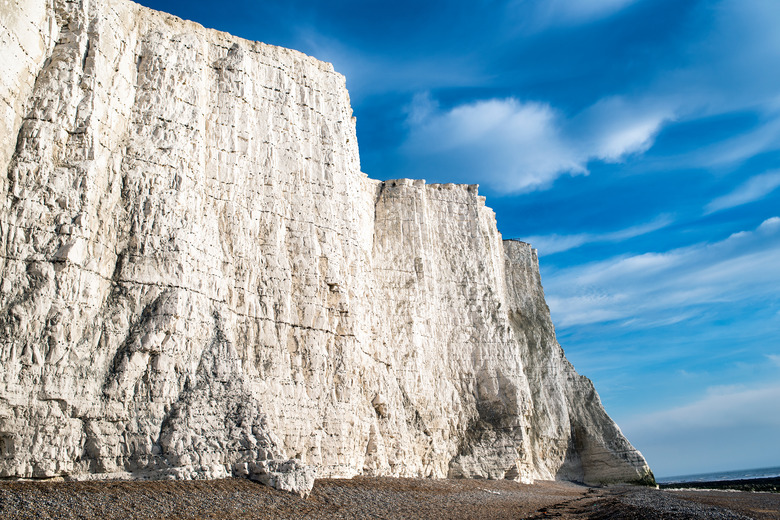The Benefits And Effects Of Limestone
As a sedimentary rock, limestone consists of the mineral calcite, shellfish fossils and other shallow-sea creatures, clay, chert, silt and dolomite. Limestone's uses are many, based on the desired effect it creates. Manufacturers use limestone for making glass. They also use it in building materials such as travertine and other decorative tiles. Gardeners put it on the lawn, contractors construct buildings and roads with it, and water treatment professionals insert it to neutralize acidic water.
TL;DR (Too Long; Didn't Read)
The benefits and effects of limestone:
* High in calcium: Helps
makes lawns green.
* Curbs pollution: Removes
sulfur dioxide from coal plant smokestacks.
* Good for ponds:
Increases nutrient availability, fish growth and alkalinity.
* Water treatment:
Helps to remove excessive iron from water, reduce water pH.
* Building materials: Is an essential component in concrete.
* Decorative floor covering: Travertine tile is a form
of banded limestone.
Wet Scrubbers and Coal Smokestacks
Wet Scrubbers and Coal Smokestacks
A plant that burns coal spews sulfur dioxides into the atmosphere, which are a greenhouse gas. Limestone, applied as a slurry, which is a mixture of minutely crushed limestone and water, helps to prevent sulfur dioxide from escaping through the plant's smokestack. The limestone traps the sulfur dioxide gas in the wet slurry with calcium and oxygen and makes the pollutant a removable solid waste.
Better Soil Alkalinity
Better Soil Alkalinity
Limestone works as an amendment to soils and lawns to increase alkalinity. Acid-loving plants like camellias, azaleas, blueberries and centipede lawns grow best with a soil pH of 5.0 to 5.5. But most plants prefer a higher pH of about 6.5 to thrive. Before adding lime to the soil, test it for alkalinity by taking samples from three to five areas in the yard about 6 inches deep. Only add lime when the soil pH is highly acidic or below 5.5. Most fruits, vegetables and a large range of plants prefer soil slightly acidic or 5.5 to 6.5 on the pH scale.
Healthy Thriving Ponds
Healthy Thriving Ponds
Plants aren't the only ones that benefit from limestone. Pond liming, a customary practice in the southeastern United States, increases nutrient availability for both fish and plants in the pond. It also provides a shield against the fluctuations in the water's acidity each day. Most farmers and rural homeowners add it to a pond's bottom to sterilize it prior to adding fish.
Water Treatment Uses
Water Treatment Uses
For homes in rural communities, many wells have acidic water that also contain high amounts of iron or ferrous byproducts. Acidic water plays havoc with copper pipes over time, which is why many people opt for water treatment tanks that contain limestone and other sands or minerals. They act as a base for changing the water's pH content as well as help to remove iron and its byproducts from the water. Water treatment tanks with automatic timers regularly backflush the nasty water collected by the limestone and other sands at the bottom of the tank and lift the sand during backflush to loosen and remove the sediments. Limestone sands and other filtration media must be changed and recharged periodically based on the water's constituents to keep the water's pH level at a neutral 7.0. This is best for drinking water and copper pipes.
Construction and Home Decor
Construction and Home Decor
Contractors use limestone as a building material, but it's also finely crushed and added to make Portland cement. On its own, limestone's natural beauty often adorns the floors of bathrooms, kitchens and other areas of the home. As decorative floor tiles, limestone offers a durable floor covering similar to granite and marble.
References
Cite This Article
MLA
Brenner, Laurie. "The Benefits And Effects Of Limestone" sciencing.com, https://www.sciencing.com/benefits-effects-limestone-7840800/. 26 April 2018.
APA
Brenner, Laurie. (2018, April 26). The Benefits And Effects Of Limestone. sciencing.com. Retrieved from https://www.sciencing.com/benefits-effects-limestone-7840800/
Chicago
Brenner, Laurie. The Benefits And Effects Of Limestone last modified March 24, 2022. https://www.sciencing.com/benefits-effects-limestone-7840800/
